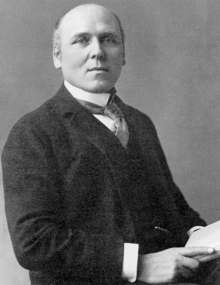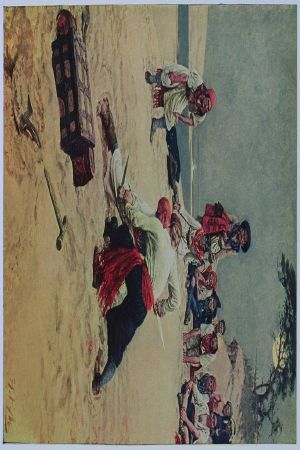Howard Pyle
| Howard Pyle | |
 | |
| Born | March 5 1853 Wilmington, Delaware, United States |
| Died | November 9 1911 (aged 58) Florence, Italy |
| Nationality | American |

Howard Pyle (March 5, 1853 – November 9, 1911) was an influential American illustrator and writer, primarily of books for young audiences. A native of Wilmington, Delaware, he opened an art school in his hometown where he taught other illustrators, including protegee, N. C. Wyeth. During the Golden Age of Illustration, Pyle, along with many illustrators trained by him, brought the printed word to life through their vivid descriptions of pirates, fair maidens and other medieval characters, such as the legendary Robin Hood.
Pyle was also a prolific writer who authored and illustrated over 24 books including The Story of King Arthur and His Knights. His attention to historical accuracy can be seen in his works depicting Revolutionary War themes, (see Thomas Jefferson Writing the Declaration of Independence, Scribner's 1898). His paintings reflect Americans love for adventure that was so popular at the turn of the century before the advent of movies, and television.
Biography
Howard Pyle was born in Wilmington, Delaware in 1853, the same year as Vincent Van Gogh. Pyle's family was steeped in Quaker tradition and he was raised with a love for the classics, history and mythology. A nontraditional student, who did not fare well in the classroom, Pyle left school at age 16 to study at an art school in Philadelphia.
In the 1870s Pyle served a short stint at the Art Students League in New York City. Many of his early illustrations appeared in magazines such as Harper's Weekly and Colliers. In 1880 he returned to Wilmington, Delaware, already an established illustrator. As one critic said of Pyle, "His rapid rise to popularity was due to his remarkable gift for seizing and expressing the dramatic gist of a story.[1]
In 1894 he began teaching illustration at the Drexel Institute of Art, Science and Industry (now Drexel University in Phiadelphia). His students at Drexel included Jessie Wilcox Smith, Elizabeth Shippen Green and Maxfield Parrish. In 1900 he founded his own school of art and illustration (later called the Brandywine School) in Wilmington, Delaware. Drawing on his love for pastoral settings and the history of the Chadds Ford Valley he cultivated a small group of elite students at his school. Among them was N. C. Wyeth who became a renowned illustrator and artist in his own right.
In 1910 he ventured to Europe in an effort to re-vitalize his carrer by taking up mural painting through studying the Old Masters. He became ill while in Florence, Italy and suddenly passed away in 1911 purportedly of Bright's Disease, the same affliction that took the life of poet Emily Dickinson.
He left unfinished on his easel the painting, The Mermaid, which was eventually finished by one of his students, Frank Schoonover. The lage painting is one of the highlights of his collection and illustrates the opposing forces of weak and strong, human versus mystical. Painted in shimmering torquoise hues, it shows a shipwrecked sailor being comforted by a visiting mermaid. Pyle, himself was fascinated with the idea of a "mysterious stranger" or visitations from the world beyond.
In another allegorical piece, The Flying Dutchman shows a wild eyed sailor, in a painting over 6 feet in height, who was condemned along with his crew to sail perptually around the Cape of Good Hope, only able to land ashore every seven years in order to seek a faithful woman who could break the curse.
Marooned a picture of abject desolation was painted at Rehobeth Beach, Delaware. It shows a pirate exiled from his crew for breaking the "pirate's code" of honor.
Major works

In addition to his numerous illustrations for periodicals and the children's books of other authors such as Robert Louis Stevenson's Dr. Jekyll and Mr. Hyde, Pyle wrote and illustrated a number of books himself based on classic tales.
The Merry Adventures of Robin Hood is Pyle's distillation of many Robin Hood legends and ballads, modified to make them suitable for the child audience he sought to appeal to. He modified the ballad "Robin Hood's Progress to Nottingham", changing it from Robin killing fourteen foresters for not paying on a bet, to the robbers threatening Robin, and Pyle has Robin kill only one man who shoots at him first. Tales where Robin steals all that a traveler carried, such as "Robin Hood and the Bishop of Hereford", were changed so that the victim keeps a third, and another third is dedicated to the poor.
Pyle did not have much more concern for historical accuracy than the ballads, though he did alter the name of the queen in "Robin Hood and Queen Katherine" to Queen Eleanor, historically compatible with the king with whom Robin made his peace being King Richard the Lion-Hearted.
Indeed, none of the tales in the book were Pyle's own invention. However, he wove the tales together to form a unified story. The adventure with the Curtal Friar, for instance, was not an isolated tale, but undertaken to bring back Friar Tuck, because a priest was needed to marry Allen A Dale to his sweetheart Ellen. Again, in "A Gest of Robyn Hode", the knight saved an anonymous wrestler who had won a bout but was likely to be murdered because he was a stranger, and Robin says that this excuses his delay, and that anyone who helps good yeomen is helpful to him; Pyle adapted it so that the wrestler was David of Doncaster, one of Robin's band in "Robin Hood and the Golden Arrow". Several characters that had appeared in only one ballad, such as David of Doncaster and Arthur a Bland, are more fully developed in this novelistic treatment of the tales.
Pyle also wrote Otto of the Silver Hand, a story about the life of the son of a robber baron in the dark ages.
Pyle compiled a number of pirate legends into his volume, Howard Pyle's Book of Pirates.
His Men of Iron was made into a movie in 1954, The Black Shield of Falworth.
Legacy
Pyle's now famous advice to his students was, "Throw your heart into the picture and then jump in after it." One biographer has described Pyle as having, "fought, sang, struggled and sobbed through his work." [2]. Like fellow illustrator Norman Rockwell he paid close attention to historical detail and often painted live models wearing period costumes. (While Rockwell later turned to painting from photographs, this medium was not yet developed during Pyle's era.)
Pyle published some 3,300 illustrations during this thirty-five year career. He wrote many of the stories he illustrated and nurtured young artists who went on to become commerically successful in their own right: artists such as N. C. Wyeth and Maxfield Parrish.
Pyle was drawn to the classics of his youth and returned again and again to themes of chivalry, courtship at the turn of the century, and embattled soldiers of the Revolutionary War period. His work is striking for its realism, its vivid colors and for its masterful historical detail.
Pyle was widely respected during his life, and continues to be highly regarded, by illustrators and fine artists.
The Delaware Art Museum, founded after Pyle's death largely for the purpose of exhibiting his paintings and preserving his legacy, is home to the largest collection of Howard Pyle's work.
Notes
ReferencesISBN links support NWE through referral fees
- Menges, Jeff A., editor. Pirates, Patriots, and Princesses: The Art of Howard Pyle, New York: Dover Publications, 2006. ISBN 0-486-44832-0
- Wondrous Strange: The Wyeth Tradition, with Essays by Stephen T. Bruni and Betsy James Wyeth, 1998. Published on occasion of the exhibition "Wondrous Strange" at Farnsworth Art Museum, Rockland, Maine.
Further Reading
- Davis, Paul Preston, Howard Pyle: His Life - His Work Oak Knoll Press ISBN 978-1584561330
Books by Howard Pyle
- The Book of Pirates, (1921), Re-published in 2000 by Harper and Brothers. ISBN 0486413047
- The Garden Behind the Moon: A Real Story of the Moon Angel (1895) Re-published in 2005 by Dover Books ISBN 0486440737
- The Wonder Clock ISBN 0765342669
- Men of Iron (Timeless Classics) ISBN 978-1434610140
- The Story of King Arthur and the His Knights with John F. Plummer ISBN 978-0451530240
- The Merry Adventures of Robin Hood with Stephen T. Knight
External links
- site with biography and etext of Robin Hood
- Works by Howard Pyle. Project Gutenberg
- etext of Twilightland
- Delaware Art Museum
Credits
New World Encyclopedia writers and editors rewrote and completed the Wikipedia article in accordance with New World Encyclopedia standards. This article abides by terms of the Creative Commons CC-by-sa 3.0 License (CC-by-sa), which may be used and disseminated with proper attribution. Credit is due under the terms of this license that can reference both the New World Encyclopedia contributors and the selfless volunteer contributors of the Wikimedia Foundation. To cite this article click here for a list of acceptable citing formats.The history of earlier contributions by wikipedians is accessible to researchers here:
The history of this article since it was imported to New World Encyclopedia:
Note: Some restrictions may apply to use of individual images which are separately licensed.

